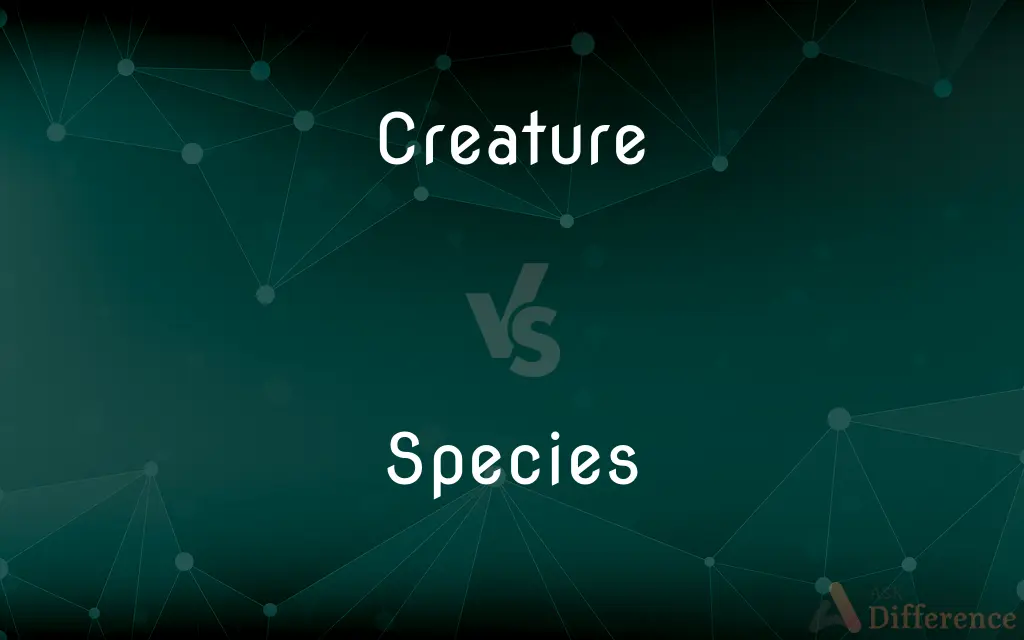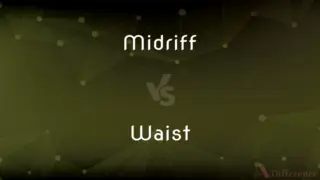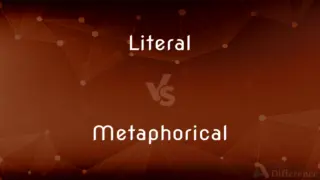Creature vs. Species — What's the Difference?
By Tayyaba Rehman & Urooj Arif — Updated on March 14, 2024
A creature is an individual living being, often used in contexts involving animals or fictional beings, while a species is a biological classification that groups individuals sharing common characteristics and the ability to interbreed.

Difference Between Creature and Species
Table of Contents
ADVERTISEMENT
Key Differences
Creatures encompass a wide range of living beings, from animals and humans to mythical entities, focusing on the individual or collective existence. Whereas, a species represents a specific group within the biological taxonomy, defined by shared traits and genetic compatibility, highlighting the broader classification rather than individual entities.
While the term "creature" evokes a sense of individuality and can be applied to any living being regardless of its biological classification, "species" is a scientific term used to categorize groups of organisms that are capable of reproducing fertile offspring, underscoring the importance of genetic continuity and diversity.
Creatures can belong to any level of biological classification, not just species, and the term is often used in a more general, sometimes colloquial sense. On the other hand, species is a precise scientific concept that plays a crucial role in understanding biodiversity, evolution, and conservation efforts.
In literature and popular culture, "creature" often carries connotations of mystery, peculiarity, or non-human characteristics, appealing to the imagination. In contrast, "species" is used in scientific and educational contexts to convey information about biological diversity, classification, and ecological relationships.
While the concept of a creature is more flexible and can be applied to individuals or groups without strict biological criteria, the identification of a species requires rigorous scientific methods, including genetic analysis and observation of reproductive capabilities, emphasizing the structured nature of biological classification.
ADVERTISEMENT
Comparison Chart
Definition
An individual living being, real or fictional.
A group of organisms sharing common characteristics and able to interbreed.
Context
Broad and general, often used colloquially.
Scientific, focused on biological classification.
Connotations
Can imply mystery, uniqueness, or non-human traits.
Associated with biodiversity, evolution, and conservation.
Flexibility
Applies to any living being at any classification level.
Strict criteria based on genetic compatibility and shared traits.
Application in Literature/Culture
Often used to evoke a sense of wonder or otherness.
Used to discuss biological diversity and ecological relationships.
Compare with Definitions
Creature
A creature is any living being, often emphasizing unique or non-human aspects.
The deep sea is home to creatures beyond our wildest imagination.
Species
A species is a fundamental category in biological taxonomy, grouping organisms that can interbreed.
The Bengal tiger is a species facing threats from habitat loss.
Creature
It can refer to humans in contexts emphasizing certain qualities or conditions.
We are all creatures of habit in our daily routines.
Species
The concept plays a key role in debates on conservation and biodiversity.
Conservation efforts often focus on preserving habitats for multiple species.
Creature
The term can apply to individuals or groups without strict biological criteria.
Creatures of the night include owls, bats, and nocturnal insects.
Species
It is used in scientific contexts to discuss ecological roles and conservation.
Protecting endangered species is crucial for maintaining ecological balance.
Creature
Creatures encompass a broad range of beings, from mundane to mythical.
Folktales often feature creatures with magical powers.
Species
Species classification aids in understanding biodiversity and evolutionary relationships.
Discovering a new species in the rainforest helps scientists understand biodiversity.
Creature
"Creature" is used in both everyday language and creative works.
The novel's hero battles fantastical creatures on his journey.
Species
Species distinctions are crucial for biological research and education.
Studying species interactions provides insights into ecosystem dynamics.
Creature
A living being, especially an animal
Land creatures.
Microscopic creatures in a drop of water.
Species
A group of living organisms consisting of similar individuals capable of exchanging genes or interbreeding. The species is the principal natural taxonomic unit, ranking below a genus and denoted by a Latin binomial, e.g. Homo sapiens.
Creature
A human.
Species
A kind or sort
A species of invective at once tough and suave
Creature
An imaginary or fantastical being
Mythological creatures.
A creature from outer space.
Species
The visible form of each of the elements of consecrated bread and wine in the Eucharist.
Creature
One dependent on or subservient to another.
Species
(Biology) A group of closely related organisms that are very similar to each other and are usually capable of interbreeding and producing fertile offspring. The species is the fundamental category of taxonomic classification, ranking below a genus or subgenus. Species names are represented in binomial nomenclature by an uncapitalized Latin adjective or noun following a capitalized genus name, as in Ananas comosus, the pineapple, and Equus caballus, the horse.
Creature
Something created.
Species
(Logic) A class of individuals or objects grouped by virtue of their common attributes and assigned a common name; a division subordinate to a genus.
Creature
A living being; an animal.
Species
(Chemistry) A set of atoms, molecules, ions, or other chemical entities that possess the same distinct characteristics with respect to a chemical process or measurement.
Creature
An unidentified, mysterious, and often monstrous animal or being.
Species
A kind, variety, or type
"No species of performing artist is as self-critical as a dancer" (Susan Sontag).
Creature
A human.
Species
The outward appearance or form of the Eucharistic elements that is retained after their consecration.
Creature
A created thing, whether animate or inanimate; a creation.
Species
Either of the consecrated elements of the Eucharist.
Creature
A being subservient to or dependent upon another.
Species
Type or kind. race.}}
The male species
A new species of war
Creature
Anything created; anything not self-existent; especially, any being created with life; an animal; a man.
He asked water, a creature so common and needful that it was against the law of nature to deny him.
God's first creature was light.
On earth, join, all ye creatures, to extolHim first, him last, him midst, and without end.
And most attractive is the fair resultOf thought, the creature of a polished mind.
Species
A group of plants or animals having similar appearance.
This species of animal is unique to the area.
Creature
A human being, in pity, contempt, or endearment; as, a poor creature; a pretty creature.
The world hath not a sweeter creature.
Species
A category in the classification of organisms, ranking below genus; a taxon at that rank.
Creature
A person who owes his rise and fortune to another; a servile dependent; an instrument; a tool.
A creature of the queen's, Lady Anne Bullen.
Both Charles himself and his creature, Laud.
Species
A particular type of atom, molecule, ion or other particle.
Creature
A general term among farmers for horses, oxen, etc.
Species
(mineralogy) A mineral with a unique chemical formula whose crystals belong to a unique crystallographic system.
Creature
A living organism characterized by voluntary movement
Species
An image, an appearance, a spectacle.
Creature
A human being; `wight' is an archaic term
Species
(obsolete) The image of something cast on a surface, or reflected from a surface, or refracted through a lens or telescope; a reflection.
I cast the species of the Sun onto a sheet of paper through a telescope.
Creature
A person who is controlled by others and is used to perform unpleasant or dishonest tasks for someone else
Species
Visible or perceptible presentation; appearance; something perceived.
Species
(Christianity) Either of the two elements of the Eucharist after they have been consecrated.
Species
Coin, or coined silver, gold, or other metal, used as a circulating medium; specie.
Species
A component part of compound medicine; a simple.
Species
Plural of specie
Species
Visible or sensible presentation; appearance; a sensible percept received by the imagination; an image.
Wit, . . . the faculty of imagination in the writer, which searches over all the memory for the species or ideas of those things which it designs to represent.
Species
A group of individuals agreeing in common attributes, and designated by a common name; a conception subordinated to another conception, called a genus, or generic conception, from which it differs in containing or comprehending more attributes, and extending to fewer individuals. Thus, man is a species, under animal as a genus; and man, in its turn, may be regarded as a genus with respect to European, American, or the like, as species.
Species
In science, a more or less permanent group of existing things or beings, associated according to attributes, or properties determined by scientific observation.
Species
A sort; a kind; a variety; as, a species of low cunning; a species of generosity; a species of cloth.
Species
Coin, or coined silver, gold, or other metal, used as a circulating medium; specie.
There was, in the splendor of the Roman empire, a less quantity of current species in Europe than there is now.
Species
A public spectacle or exhibition.
Species
A component part of a compound medicine; a simple.
Species
The form or shape given to materials; fashion or shape; form; figure.
Species
(biology) taxonomic group whose members can interbreed
Species
A specific kind of something;
A species of molecule
A species of villainy
Common Curiosities
What defines a creature?
A creature is any individual living being, ranging from animals and humans to fictional beings in literature and culture.
How do creatures differ from species?
Creatures refer to individual living beings, with a broader, more general application, while species are specific groups defined by shared traits and reproductive compatibility.
What is the significance of species classification?
Species classification helps scientists understand biodiversity, evolutionary relationships, and ecological dynamics, and it is crucial for conservation efforts.
What is a species in biological terms?
In biology, a species is a group of organisms that share common characteristics and are capable of interbreeding to produce fertile offspring.
Can the term "creature" have negative connotations?
Yes, in some contexts, "creature" might be used to imply something strange, frightening, or less than human.
Why is species conservation important?
Species conservation is vital for maintaining biodiversity, ecosystem stability, and the many ecological services that support life on Earth, including human life.
Can the term "creature" apply to plants?
While less common, "creature" can be used in a broad sense that includes plants, especially in contexts emphasizing living aspects or uniqueness.
How does the concept of a species contribute to evolutionary studies?
Understanding species helps scientists track evolutionary processes, including speciation, adaptation, and extinction events.
How is the concept of a creature used in conservation?
While "creature" is less commonly used in formal conservation contexts, it can help engage the public's imagination and empathy towards conserving diverse living beings.
Can fictional creatures influence scientific inquiry?
Yes, fictional creatures can inspire scientific curiosity and exploration, leading to new discoveries and a deeper appreciation for the diversity of life.
Is every creature part of a species?
Yes, every real creature is part of a species, but in fiction and mythology, creatures may not fit into biological classifications.
How are new species identified?
New species are identified through scientific research involving morphological, genetic, and reproductive analyses to determine distinct biological characteristics.
What role do creatures play in ecosystems?
Creatures, each belonging to various species, play diverse roles in ecosystems, contributing to functions like pollination, predation, decomposition, and more.
How do cultural representations of creatures influence perceptions?
Cultural representations, such as in mythology or media, can shape how we perceive certain creatures, often imbuing them with symbolic meanings or moral lessons.
Are species classifications permanent?
Species classifications can change based on new scientific discoveries and understandings of genetic, morphological, and reproductive traits.
Share Your Discovery

Previous Comparison
Midriff vs. Waist
Next Comparison
Literal vs. MetaphoricalAuthor Spotlight
Written by
Tayyaba RehmanTayyaba Rehman is a distinguished writer, currently serving as a primary contributor to askdifference.com. As a researcher in semantics and etymology, Tayyaba's passion for the complexity of languages and their distinctions has found a perfect home on the platform. Tayyaba delves into the intricacies of language, distinguishing between commonly confused words and phrases, thereby providing clarity for readers worldwide.
Co-written by
Urooj ArifUrooj is a skilled content writer at Ask Difference, known for her exceptional ability to simplify complex topics into engaging and informative content. With a passion for research and a flair for clear, concise writing, she consistently delivers articles that resonate with our diverse audience.














































